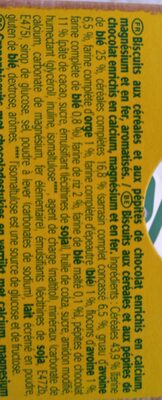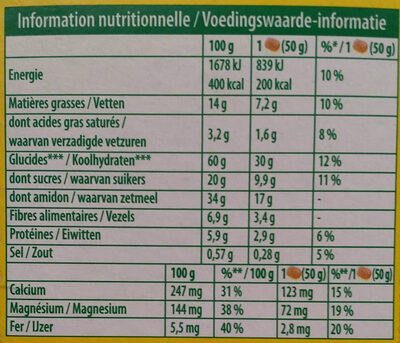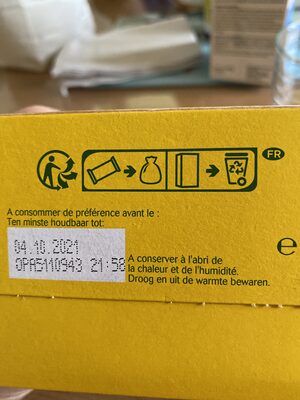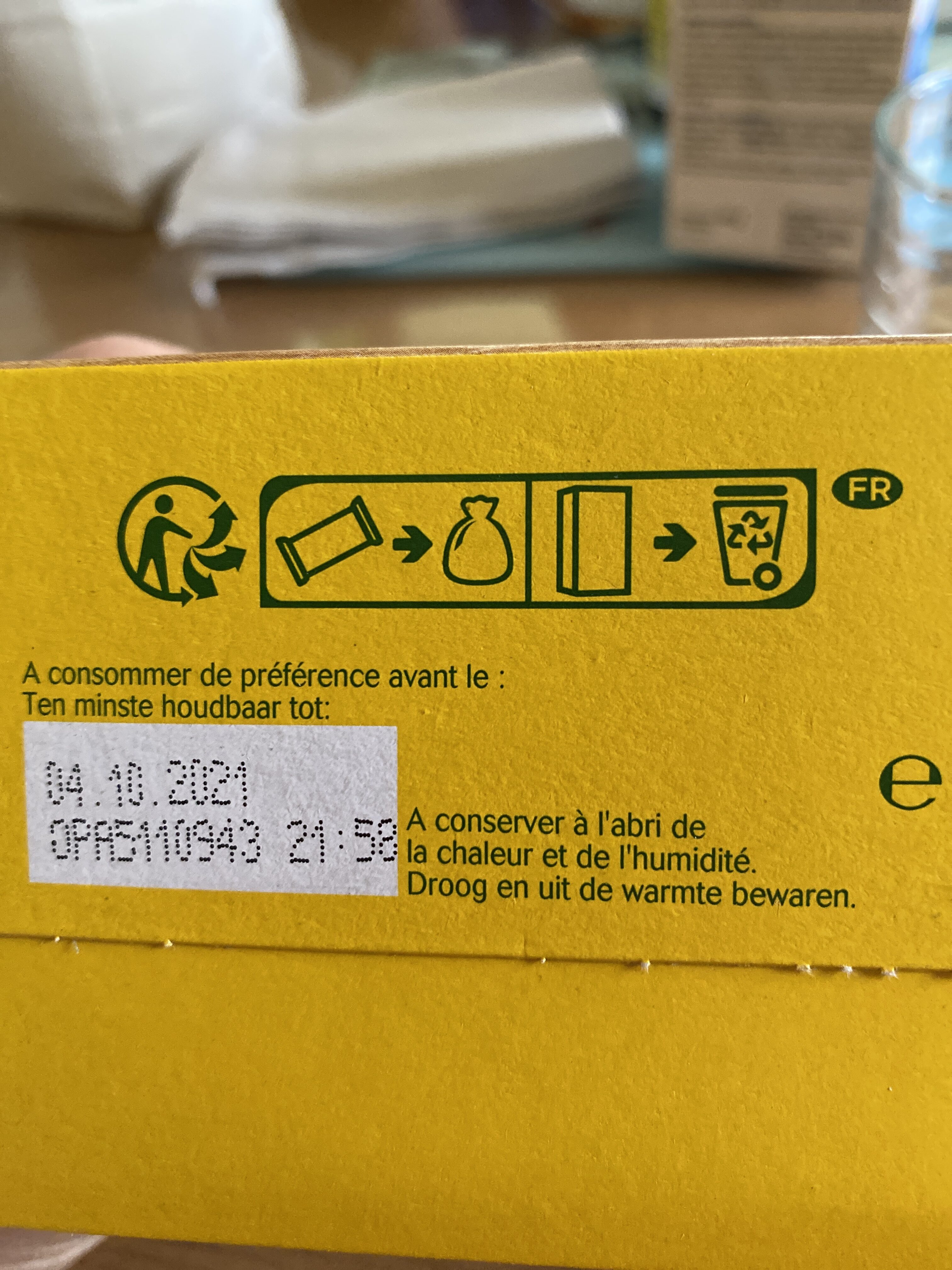Help us make food transparency the norm!
As a non-profit organization, we depend on your donations to continue informing consumers around the world about what they eat.
The food revolution starts with you!
Biscuit aux céréales et pépites de chocolat - LU - 250 g e (5 * 50 g)
Biscuit aux céréales et pépites de chocolat - LU - 250 g e (5 * 50 g)
Barcode: 7622210444141 (EAN / EAN-13)
Common name: Biscuit aux céréales et pépites de chocolat
Quantity: 250 g e (5 * 50 g)
Packaging: Container, Plastique
Categories: Snacks, Sweet snacks, Biscuits and cakes, Biscuits, Chocolate biscuits, Biscuits au chocolat, Biscuits et gâteaux, Snacks sucrés, Surgelés
Labels, certifications, awards:
Green Dot, Isomaltulose is a source of glucose and fructose
Origin of ingredients: France
Manufacturing or processing places: France
Stores: Monoprix, Auchan, Super U, carrefour.fr, E.leclerc, Magasins U, Carrefour Market, Carrefour City, Carrefour
Countries where sold: Belgium, France, Switzerland
Matching with your preferences
Health
Ingredients
-
41 ingredients
: Céréales 43,9% farine de blé 25 %, céréales complètes 16,8 % (sarrasin complet concassé 6,5 %, gruau d'avoine 6,5 %, farine complète d'orge 1 %, farine complète d'épeautre (blé) 1%, flocons d'avoine 1 %, farine complète de blé 0,8 %), farine de riz 2 %, farine de blé malté 0,1 %, pépites de chocolat 11% [pâte de cacao, sucre, émulsifiant (lécithines de sojal, huile de colza, sucre, amidon modifié humectant (glycérol), inuline, isomaltulose****, agent de charge (maltitol), minéraux (carbonate de calcium, carbonate de magnésium, fer élémentaire), émulsifiants (lécithines de soja, E472b, E475), sirop de glucose, sel, poudre à lever (carbonates de sodium), lait écrémé en poudre, gluten de blé, dextrose, arômes. **** l'isomaltulose est une source de glucose et de fructose. um nesiumAllergens: Gluten, Milk, Soybeans
Food processing
-
Ultra processed foods
Elements that indicate the product is in the 4 - Ultra processed food and drink products group:
- Additive: E14XX - Modified Starch
- Additive: E322 - Lecithins
- Additive: E422 - Glycerol
- Additive: E472b - Lactic acid esters of mono- and diglycerides of fatty acids
- Additive: E475 - Polyglycerol esters of fatty acids
- Additive: E965 - Maltitol
- Ingredient: Bulking agent
- Ingredient: Dextrose
- Ingredient: Emulsifier
- Ingredient: Flavouring
- Ingredient: Glucose
- Ingredient: Glucose syrup
- Ingredient: Gluten
Food products are classified into 4 groups according to their degree of processing:
- Unprocessed or minimally processed foods
- Processed culinary ingredients
- Processed foods
- Ultra processed foods
The determination of the group is based on the category of the product and on the ingredients it contains.
Additives
-
E322 - Lecithins
Lecithins are natural compounds commonly used in the food industry as emulsifiers and stabilizers.
Extracted from sources like soybeans and eggs, lecithins consist of phospholipids that enhance the mixing of oil and water, ensuring smooth textures in various products like chocolates, dressings, and baked goods.
They do not present any known health risks.
-
E322i - Lecithin
Lecithins are natural compounds commonly used in the food industry as emulsifiers and stabilizers.
Extracted from sources like soybeans and eggs, lecithins consist of phospholipids that enhance the mixing of oil and water, ensuring smooth textures in various products like chocolates, dressings, and baked goods.
They do not present any known health risks.
-
E422 - Glycerol
Glycerol: Glycerol -; also called glycerine or glycerin; see spelling differences- is a simple polyol compound. It is a colorless, odorless, viscous liquid that is sweet-tasting and non-toxic. The glycerol backbone is found in all lipids known as triglycerides. It is widely used in the food industry as a sweetener and humectant and in pharmaceutical formulations. Glycerol has three hydroxyl groups that are responsible for its solubility in water and its hygroscopic nature.Source: Wikipedia
-
E500 - Sodium carbonates
Sodium carbonates (E500) are compounds commonly used in food preparation as leavening agents, helping baked goods rise by releasing carbon dioxide when they interact with acids.
Often found in baking soda, they regulate the pH of food, preventing it from becoming too acidic or too alkaline. In the culinary world, sodium carbonates can also enhance the texture and structure of foods, such as noodles, by modifying the gluten network.
Generally recognized as safe, sodium carbonates are non-toxic when consumed in typical amounts found in food.
-
E965 - Maltitol
Maltitol: Maltitol is a sugar alcohol -a polyol- used as a sugar substitute. It has 75–90% of the sweetness of sucrose -table sugar- and nearly identical properties, except for browning. It is used to replace table sugar because it is half as caloric, does not promote tooth decay, and has a somewhat lesser effect on blood glucose. In chemical terms, maltitol is known as 4-O-α-glucopyranosyl-D-sorbitol. It is used in commercial products under trade names such as Lesys, Maltisweet and SweetPearl.Source: Wikipedia
Ingredients analysis
-
May contain palm oil
Ingredients that may contain palm oil: E472b
-
Non-vegan
Non-vegan ingredients: Skimmed milk powderSome ingredients could not be recognized.
We need your help!
You can help us recognize more ingredients and better analyze the list of ingredients for this product and others:
- Edit this product page to correct spelling mistakes in the ingredients list, and/or to remove ingredients in other languages and sentences that are not related to the ingredients.
- Add new entries, synonyms or translations to our multilingual lists of ingredients, ingredient processing methods, and labels.
If you would like to help, join the #ingredients channel on our Slack discussion space and/or learn about ingredients analysis on our wiki. Thank you!
-
Vegetarian status unknown
Unrecognized ingredients: fr:cereales-43-9-farine-de-ble, fr:gruau-d-avoine, fr:lecithines-de-sojal, fr:amidon-modifie-humectant, Isomaltulose, Elemental iron, fr:um-nesiumSome ingredients could not be recognized.
We need your help!
You can help us recognize more ingredients and better analyze the list of ingredients for this product and others:
- Edit this product page to correct spelling mistakes in the ingredients list, and/or to remove ingredients in other languages and sentences that are not related to the ingredients.
- Add new entries, synonyms or translations to our multilingual lists of ingredients, ingredient processing methods, and labels.
If you would like to help, join the #ingredients channel on our Slack discussion space and/or learn about ingredients analysis on our wiki. Thank you!
-
Details of the analysis of the ingredients
We need your help!
Some ingredients could not be recognized.
We need your help!
You can help us recognize more ingredients and better analyze the list of ingredients for this product and others:
- Edit this product page to correct spelling mistakes in the ingredients list, and/or to remove ingredients in other languages and sentences that are not related to the ingredients.
- Add new entries, synonyms or translations to our multilingual lists of ingredients, ingredient processing methods, and labels.
If you would like to help, join the #ingredients channel on our Slack discussion space and/or learn about ingredients analysis on our wiki. Thank you!
: Céréales 43.9% farine de blé 25%, céréales complètes 16.8% (sarrasin complet 6.5%, gruau d'avoine 6.5%, farine complète d'orge 1%, farine complète d'épeautre 1% (blé), flocons d'avoine 1%, farine complète de blé 0.8%), farine de riz 2%, farine de blé malté 0.1%, pépites de chocolat 11%, pâte de cacao, sucre, émulsifiant, lécithines de sojal, huile de colza, sucre, amidon modifié humectant (glycérol), inuline, isomaltulose, agent de charge (maltitol), minéraux (carbonate de calcium, carbonate de magnésium, fer élémentaire), émulsifiants (lécithines de soja, e472b, e475), sirop de glucose, sel, poudre à lever (carbonates de sodium), lait écrémé en poudre, gluten de blé, dextrose, arômes, um nesium- Céréales 43.9% farine de blé -> fr:cereales-43-9-farine-de-ble - percent: 25
- céréales complètes -> en:wholemeal-cereal - vegan: yes - vegetarian: yes - percent: 16.8
- sarrasin complet -> en:wholemeal-buckwheat - vegan: yes - vegetarian: yes - ciqual_food_code: 9380 - percent: 6.5
- gruau d'avoine -> fr:gruau-d-avoine - percent: 6.5
- farine complète d'orge -> en:wholemeal-barley-flour - vegan: yes - vegetarian: yes - ciqual_food_code: 9550 - percent: 1
- farine complète d'épeautre -> en:wholemeal-spelt-flour - vegan: yes - vegetarian: yes - ciqual_food_code: 9480 - percent: 1
- blé -> en:wheat - vegan: yes - vegetarian: yes - ciqual_proxy_food_code: 9410
- flocons d'avoine -> en:oat-flakes - vegan: yes - vegetarian: yes - ciqual_food_code: 9311 - percent: 1
- farine complète de blé -> en:whole-wheat-flour - vegan: yes - vegetarian: yes - ciqual_proxy_food_code: 9410 - percent: 0.8
- farine de riz -> en:rice-flour - vegan: yes - vegetarian: yes - ciqual_food_code: 9520 - percent: 2
- farine de blé malté -> en:malted-wheat-flour - vegan: yes - vegetarian: yes - ciqual_proxy_food_code: 9410 - percent: 0.1
- pépites de chocolat -> en:chocolate-chunk - vegan: maybe - vegetarian: yes - ciqual_proxy_food_code: 31005 - percent: 11
- pâte de cacao -> en:cocoa-paste - vegan: yes - vegetarian: yes - ciqual_proxy_food_code: 16030
- sucre -> en:sugar - vegan: yes - vegetarian: yes - ciqual_proxy_food_code: 31016
- émulsifiant -> en:emulsifier
- lécithines de sojal -> fr:lecithines-de-sojal
- huile de colza -> en:colza-oil - vegan: yes - vegetarian: yes - from_palm_oil: no - ciqual_food_code: 17130
- sucre -> en:sugar - vegan: yes - vegetarian: yes - ciqual_proxy_food_code: 31016
- amidon modifié humectant -> fr:amidon-modifie-humectant
- glycérol -> en:e422 - vegan: maybe - vegetarian: maybe
- inuline -> en:inulin - vegan: yes - vegetarian: yes
- isomaltulose -> en:isomaltulose
- agent de charge -> en:bulking-agent
- maltitol -> en:e965 - vegan: yes - vegetarian: yes
- minéraux -> en:minerals
- carbonate de calcium -> en:e170i - vegan: maybe - vegetarian: maybe
- carbonate de magnésium -> en:e504i - vegan: yes - vegetarian: yes
- fer élémentaire -> en:elemental-iron
- émulsifiants -> en:emulsifier
- lécithines de soja -> en:soya-lecithin - vegan: yes - vegetarian: yes - ciqual_food_code: 42200
- e472b -> en:e472b - vegan: maybe - vegetarian: maybe - from_palm_oil: maybe
- e475 -> en:e475 - vegan: maybe - vegetarian: maybe
- sirop de glucose -> en:glucose-syrup - vegan: yes - vegetarian: yes - ciqual_proxy_food_code: 31016
- sel -> en:salt - vegan: yes - vegetarian: yes - ciqual_food_code: 11058
- poudre à lever -> en:raising-agent
- carbonates de sodium -> en:e500 - vegan: yes - vegetarian: yes
- lait écrémé en poudre -> en:skimmed-milk-powder - vegan: no - vegetarian: yes - ciqual_food_code: 19054
- gluten de blé -> en:wheat-gluten - vegan: yes - vegetarian: yes
- dextrose -> en:dextrose - vegan: yes - vegetarian: yes - ciqual_proxy_food_code: 31016
- arômes -> en:flavouring - vegan: maybe - vegetarian: maybe
- um nesium -> fr:um-nesium
Nutrition
-
Average nutritional quality
⚠ ️Warning: the amount of fruits, vegetables and nuts is not specified on the label, it was estimated from the list of ingredients: 1This product is not considered a beverage for the calculation of the Nutri-Score.
Positive points: 5
- Proteins: 3 / 5 (value: 5.9, rounded value: 5.9)
- Fiber: 5 / 5 (value: 6.9, rounded value: 6.9)
- Fruits, vegetables, nuts, and colza/walnut/olive oils: 0 / 5 (value: 1.409375, rounded value: 1.4)
Negative points: 14
- Energy: 5 / 10 (value: 1678, rounded value: 1678)
- Sugars: 4 / 10 (value: 20, rounded value: 20)
- Saturated fat: 3 / 10 (value: 3.2, rounded value: 3.2)
- Sodium: 2 / 10 (value: 228, rounded value: 228)
The points for proteins are not counted because the negative points are greater or equal to 11.
Nutritional score: (14 - 5)
Nutri-Score:
-
Nutrient levels
-
Fat in moderate quantity (14%)
What you need to know- A high consumption of fat, especially saturated fats, can raise cholesterol, which increases the risk of heart diseases.
Recommendation: Limit the consumption of fat and saturated fat- Choose products with lower fat and saturated fat content.
-
Saturated fat in moderate quantity (3.2%)
What you need to know- A high consumption of fat, especially saturated fats, can raise cholesterol, which increases the risk of heart diseases.
Recommendation: Limit the consumption of fat and saturated fat- Choose products with lower fat and saturated fat content.
-
Sugars in high quantity (20%)
What you need to know- A high consumption of sugar can cause weight gain and tooth decay. It also augments the risk of type 2 diabetes and cardio-vascular diseases.
Recommendation: Limit the consumption of sugar and sugary drinks- Sugary drinks (such as sodas, fruit beverages, and fruit juices and nectars) should be limited as much as possible (no more than 1 glass a day).
- Choose products with lower sugar content and reduce the consumption of products with added sugars.
-
Salt in moderate quantity (0.57%)
What you need to know- A high consumption of salt (or sodium) can cause raised blood pressure, which can increase the risk of heart disease and stroke.
- Many people who have high blood pressure do not know it, as there are often no symptoms.
- Most people consume too much salt (on average 9 to 12 grams per day), around twice the recommended maximum level of intake.
Recommendation: Limit the consumption of salt and salted food- Reduce the quantity of salt used when cooking, and don't salt again at the table.
- Limit the consumption of salty snacks and choose products with lower salt content.
-
-
Nutrition facts
Nutrition facts As sold
for 100 g / 100 mlAs sold
per serving (50g)Compared to: Biscuits-au-chocolat Energy 1,678 kj
(400 kcal)839 kj
(200 kcal)-19% Fat 14 g 7 g -40% Saturated fat 3.2 g 1.6 g -72% Arachidic acid 0.003 g 0.001 g Behenic acid 0.003 g 0.002 g Alpha-linolenic acid 0.123 g 0.062 g Arachidonic acid 0.072 g 0.036 g Carbohydrates 60 g 30 g -4% Sugars 20 g 10 g -38% Starch 0.003 g 0.002 g Fiber 6.9 g 3.45 g +92% Proteins 5.9 g 2.95 g -4% Salt 0.57 g 0.285 g +5% Alcohol 0 % vol 0 % vol Vitamin B6 (Pyridoxin) 0 mg 0 mg Vitamin B9 (Folic acid) 0 µg 0 µg Calcium 0.123 mg 0.062 mg Iron 0.006 mg 0.003 mg Magnesium 0.144 mg 0.072 mg Fruits‚ vegetables‚ nuts and rapeseed‚ walnut and olive oils (estimate from ingredients list analysis) 1.409 % 1.409 %
Environment
-
Eco-Score C - Moderate environmental impact
⚠ ️Select a country in order to include the full impact of transportation.The Eco-Score is an experimental score that summarizes the environmental impacts of food products.→ The Eco-Score was initially developped for France and it is being extended to other European countries. The Eco-Score formula is subject to change as it is regularly improved to make it more precise and better suited to each country.Life cycle analysis
-
Average impact of products of the same category: C (Score: 56/100)
Category: Biscuit (cookie), with chocolate, prepacked
Category: Biscuit (cookie), with chocolate, prepacked
- PEF environmental score: 0.47 (the lower the score, the lower the impact)
- including impact on climate change: 5.92 kg CO2 eq/kg of product
Stage Impact Agriculture
63.6 %Processing
29.8 %Packaging
2.3 %Transportation
3.2 %Distribution
1.0 %Consumption
0.0 %
Bonuses and maluses
-
Origins of ingredients with a medium impact
Bonus: +4
Environmental policy: +4
Transportation: 0
Origin of the product and/or its ingredients % of ingredients Impact France 100 %Medium
-
Packaging with a medium impact
Malus: -11
Shape Material Recycling Impact Unknown Plastic High Unknown Cardboard Low ⚠ ️ The information about the packaging of this product is not sufficiently precise (exact shapes and materials of all components of the packaging).⚠ ️ For a more precise calculation of the Eco-Score, you can modify the product page and add them.
If you are the manufacturer of this product, you can send us the information with our free platform for producers.
Eco-Score for this product
-
Impact for this product: C (Score: 49/100)
Product: Biscuit aux céréales et pépites de chocolat - LU - 250 g e (5 * 50 g)
Life cycle analysis score: 56
Sum of bonuses and maluses: -7
Final score: 49/100
-
Carbon footprint
-
Equal to driving 3.1 km in a petrol car
592 g CO² per 100g of product
The carbon emission figure comes from ADEME's Agribalyse database, for the category: Biscuit (cookie), with chocolate, prepacked (Source: ADEME Agribalyse Database)
Stage Impact Agriculture
52.9 %Processing
42.0 %Packaging
1.9 %Transportation
2.9 %Distribution
0.3 %Consumption
0.0 %
Packaging
-
Packaging with a medium impact
-
Packaging parts
(Plastic)
(Cardboard)
-
Packaging materials
Material % Packaging weight Packaging weight per 100 g of product Paper or cardboard Plastic Total
-
Transportation
-
Origins of ingredients
Origins of ingredients with a medium impact
Origin of the product and/or its ingredients % of ingredients Impact France 100 %Medium
Report a problem
-
Incomplete or incorrect information?
Category, labels, ingredients, allergens, nutritional information, photos etc.
If the information does not match the information on the packaging, please complete or correct it. Open Food Facts is a collaborative database, and every contribution is useful for all.
Data sources
Product added on by openfoodfacts-contributors
Last edit of product page on by openfoodfacts-contributors.
Product page also edited by additives-app-chakib, beniben, bobobeauvais, brpiron, cgaborit-isabelle-wanadoo-fr, countrybot, cylou77, date-limite-app, dorado-jerome, driveoff, gildubs, hungergames, kiliweb, lucaa, magasins-u, maths23, moon-rabbit, nipi39, off.18850cc4-aa59-4942-abca-a62a53d3d81a, packbot, quechoisir, scanbot, sebleouf, smoothie-app, spotter, tacinte, tacite, tacite-mass-editor, thaialagata, valery, yd31, yuka.R1pvQ0liVSttdnNsaHRvdnhBcisrc2hyK3NhU1hGNnRPN1pQSVE9PQ, yuka.R3BvY0FvTThwTm9TaFBFWndnejNxdUFvekxPakFYMnZMdTg0SVE9PQ, yuka.RnZ3Zk5LRURwTklFdHRwa3pETHgwKzFVKzY2MFVUK3RjdXNjSVE9PQ, yuka.UWZrcFRmZ2dudE0xbmZNOXB5dkgzKzlWdzVDcVFIdTdGN1lQSWc9PQ, yuka.UkxrOUtvb0YvcWthc2ZROHBEVE00ZkJlK2FXaUFrZWFFY2dmSWc9PQ, yuka.UkxrdFBwc2VsNlphc01FMHdUbno5K2gyNExHMVFrS21LdFFlSWc9PQ, yuka.V0sweUNMb3FwZmhWdHZNeTVCVFkyYzBxK3M2V1ZGNm5kOFFBSVE9PQ, yuka.V3FFeURhVUUrK0VscS9ZQzlFM1l3TnRKN3FPSVdFR0lHY2hBSUE9PQ, yuka.WVpFakxacGZpYVVicFAwUTJpbkp4c0pLbHNLdURFT1ZFTUVJSWc9PQ, yuka.WnFzSEtQMVpnc2s3Z01ZUTN6RHF3OXh1N3JHbllYS3pkOW9CSVE9PQ, yuka.YUlNWU1iNHduZVVucXM4YThpL0k4OHBLMjZid2ZIcTROYzhwSVE9PQ, yuka.YVA1WkdhZ2ZuLzQ3bHNVODJFN1hvL3R2L3FhQWZsMnVKOWdVSWc9PQ, yuka.ZjZJdEhyVllvOFFXblBRa3hRL1g2OUoreW9HdVVtbUpLN1JMSUE9PQ, yuka.Zlo0NEgvOGdoK1F5cGMwQnhEN1ZvYzFXNkpTTWZFaWFBclU3SVE9PQ, yuka.sY2b0xO6T85zoF3NwEKvlm5kWP7loAPUDCfSkHCS5siEM83zZuop-dT2HKs.












